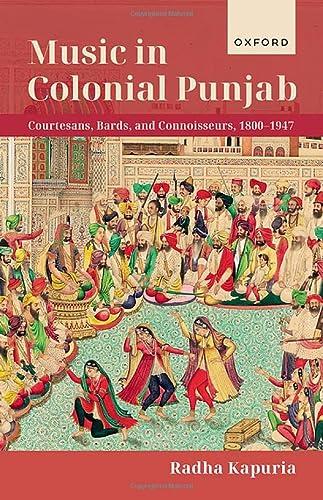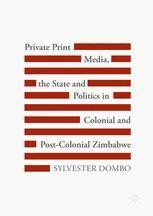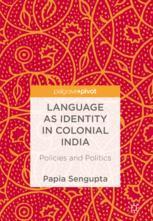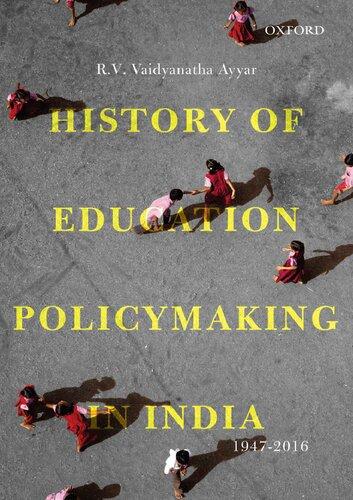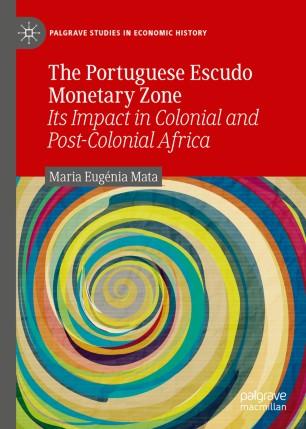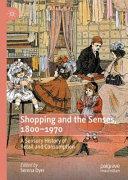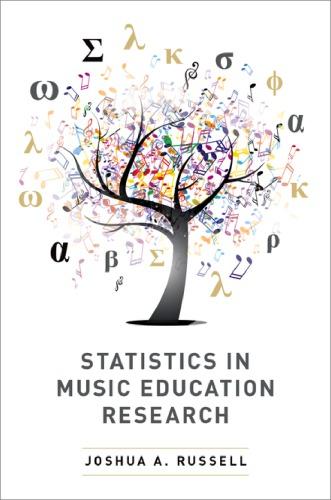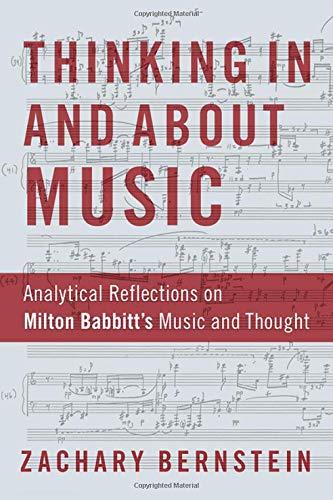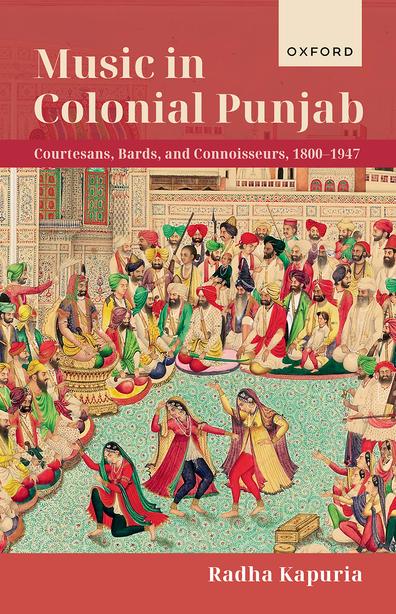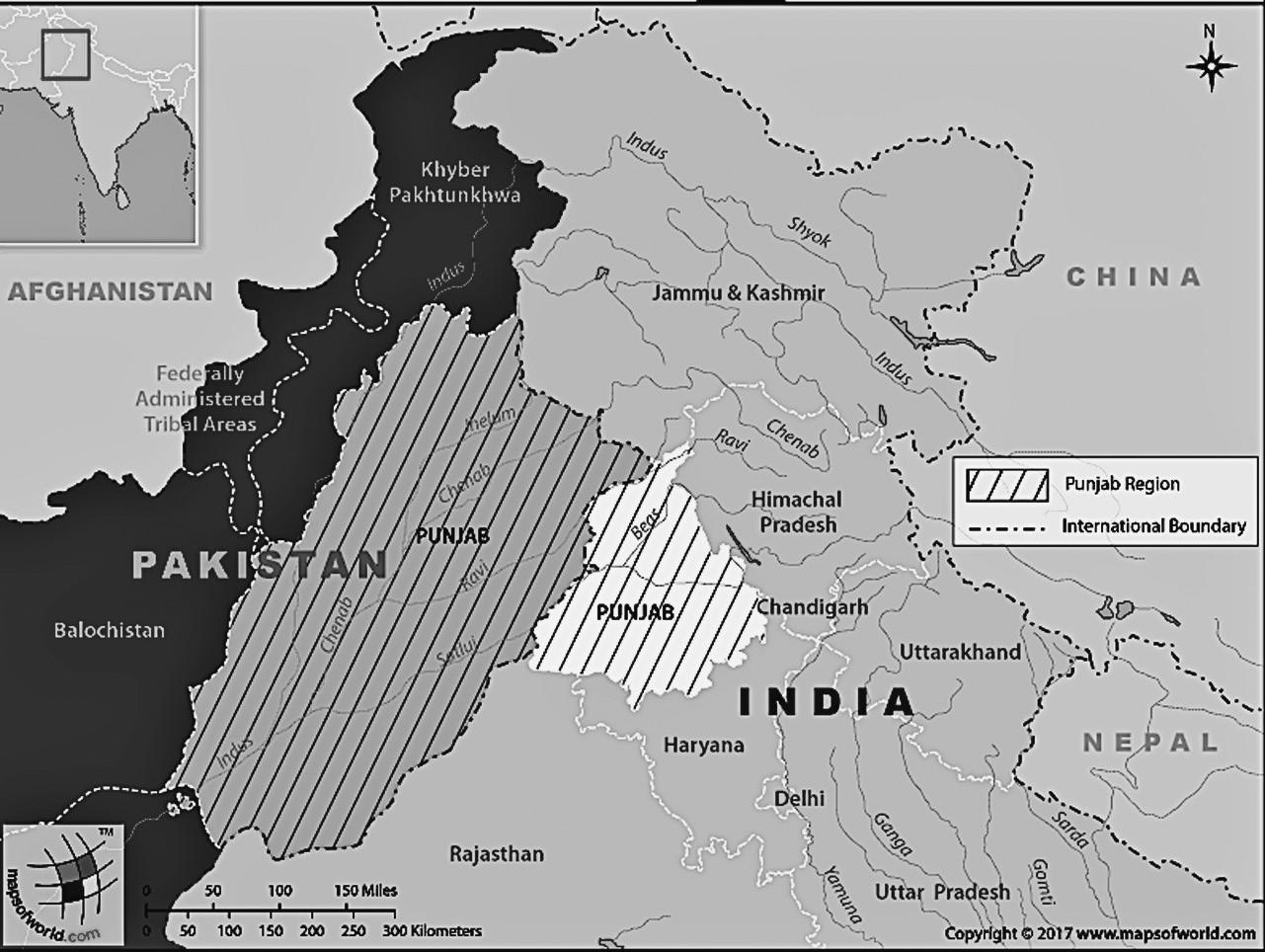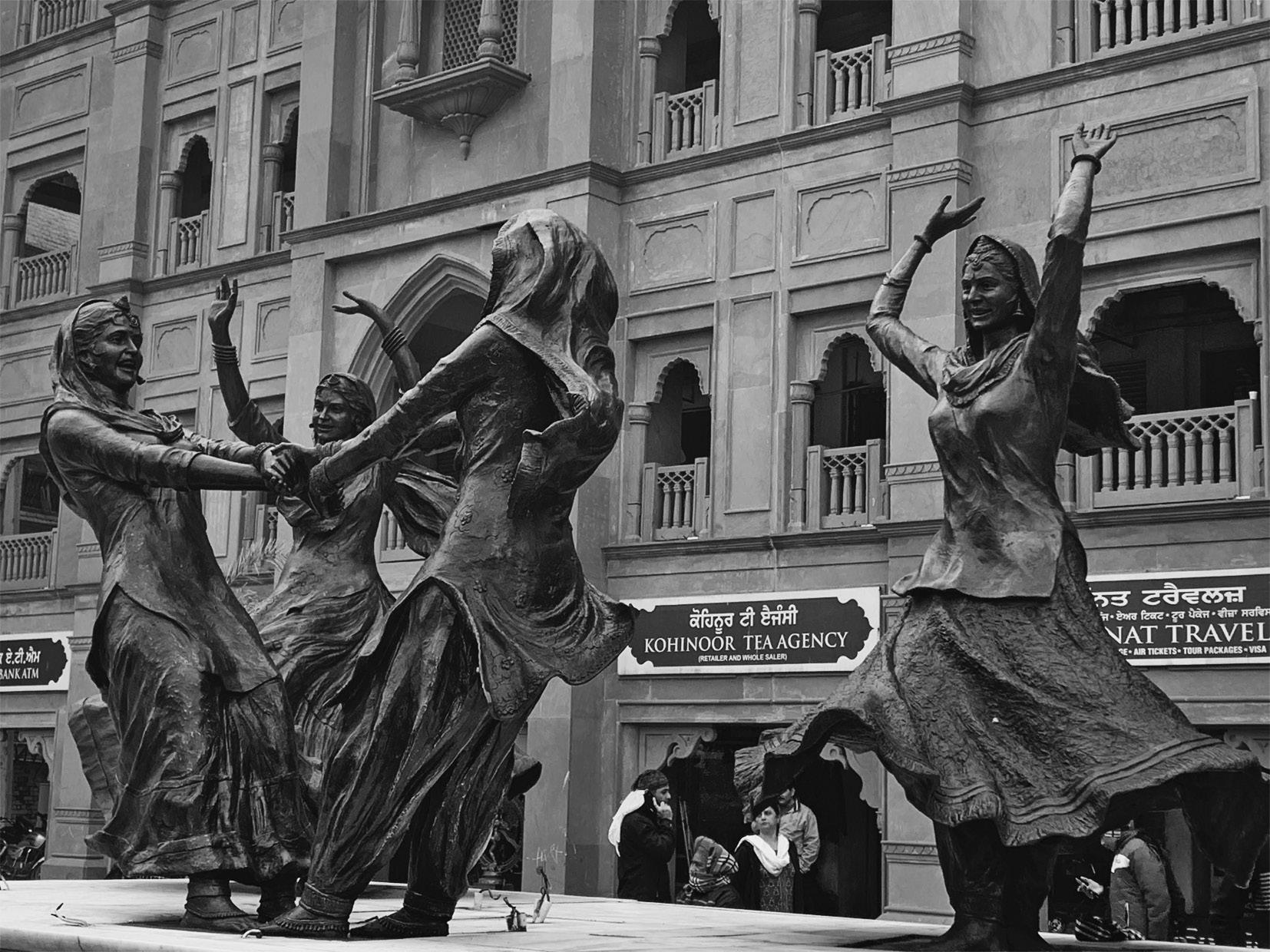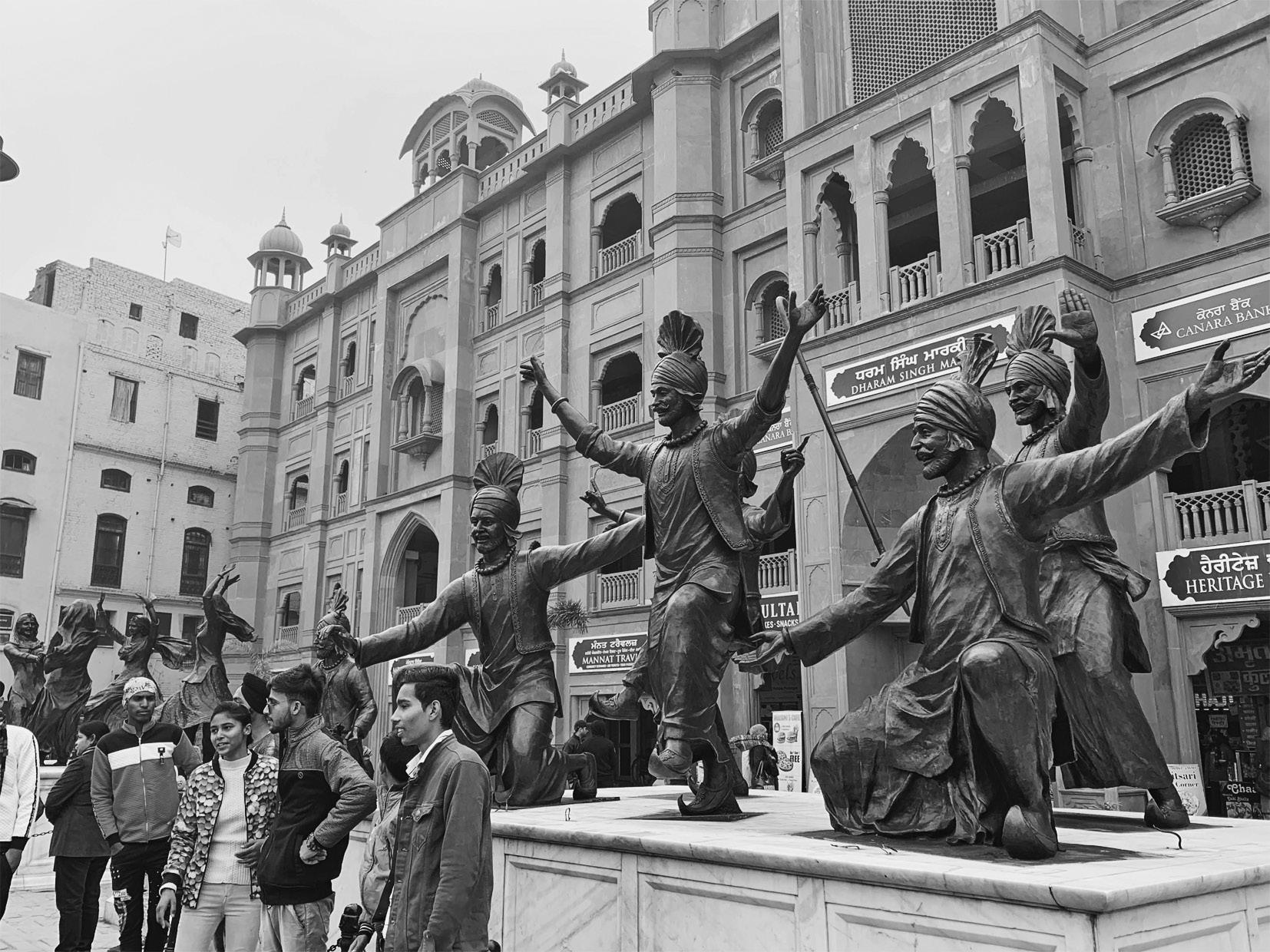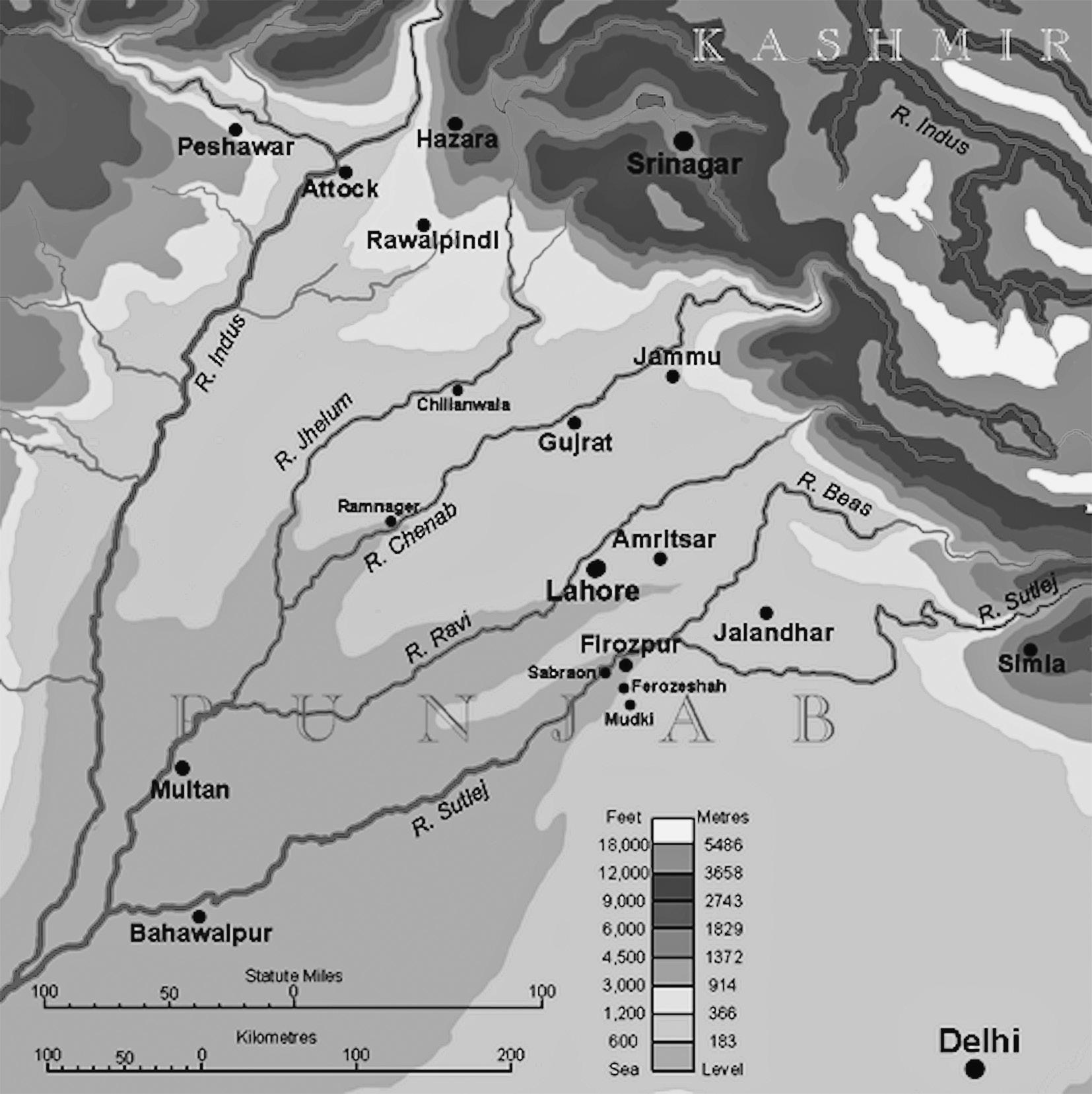Music in Colonial Punjab
Courtesans, Bards, and Connoisseurs,
1800–1947
RADHA KAPURIA
Great Clarendon Street, Oxford, OX2 6DP, United Kingdom
Oxford University Press is a department of the University of Oxford. It furthers the University’s objective of excellence in research, scholarship, and education by publishing worldwide. Oxford is a registered trade mark of Oxford University Press in the UK and in certain other countries
© Oxford University Press 2023
Te moral rights of the author have been asserted
First Edition published in 2023
All rights reserved. No part of this publication may be reproduced, stored in a retrieval system, or transmitted, in any form or by any means, without the prior permission in writing of Oxford University Press, or as expressly permitted by law, by licence or under terms agreed with the appropriate reprographics rights organization. Enquiries concerning reproduction outside the scope of the above should be sent to the Rights Department, Oxford University Press, at the address above
You must not circulate this work in any other form and you must impose this same condition on any acquirer
Published in the United States of America by Oxford University Press 198 Madison Avenue, New York, NY 10016, United States of America
British Library Cataloguing in Publication Data Data available
Library of Congress Control Number: 2023932980
ISBN 978–0–19–286734–6
DOI: 10.1093/oso/9780192867346.001.0001
Printed and bound in India by Replika Press Pvt. Ltd.
Links to third party websites are provided by Oxford in good faith and for information only. Oxford disclaims any responsibility for the materials contained in any third party website referenced in this work.
To Rajmohini & Hari Krishan Khurana, And their daughter Bindu: The music in your journeys led me here.
In gratitude to Fr. Oswald Summerton S.J. Prof. Vijaya Ramaswamy & beloved Simcha; But also for Dr Pushkar Raj Kapuria & his son Rajiv: The legacies of the heart are beyond measure.
1. Of Musicians, Dancers, and the Maharaja: Gender, Power, and Affect in Ranjit Singh’s Lahore
2. Mirāsīs, Missionaries, and Memsahibs: Folklore and Music in Colonial Punjab
3. Gender, Reform, and Punjab’s Musical Publics: Colonial Lahore, Amritsar, and Jalandhar, 1870s–1930s
4. Princely Patronage and Musicians: Modernity and Circulation in Colonial Patiala and Kapurthala
0.1. Present-day Punjab, across India and Pakistan xxiv
I.1. Te ‘dancing statues’ in Amritsar’s Heritage Walkway, December 2019 2
I.2. Colonial Punjab, ‘Te Land of the Five Rivers’ 4
I.3. Illustration from Qissā Hīr va Ranjhā (1744) of female musicians (top) and of Hir’s father Chuchek Khan, listening to musicians (bottom) 11
1.2. Maharaja Ranjit Singh in a Bazaar, 1840/1845 41
1.3. Standing fgure playing a tamburā. Faquir Bunga Nath of Lahore, 22 January 1836, by Godfrey Vigne 44
1.4. Portrait of a seated musician holding a trumpet, Lahore, 1840s 50
1.5. Sikh dancing girl, Lahore by Godfrey Vigne, c.1835–1837 60
1.6. ‘Kashemirian’ dancing girl, by Godfrey Vigne, c.1835–1837 61
1.7. ‘An amorous Sikh couple. Love at frst sight; Beauty of the Court of Runjeet Singh by Godfrey Kneller of the Court’, 1826–67 64
1.8. Ranjit Singh’s nautch girls depicted with cups of wine 65
1.9. Akālī Nihaṅg men perform the gatkā dance, 2017 77
1.10. A girl dances the kuharwā dance accompanied by musicians 78
1.11. A dancing girl with musicians performing for a Sikh nobleman 84
1.12. Painted mural panel on the north wall of the Sheesh Mahal at Lahore Fort, September 2019 89
1.13. ‘Amazon’ with sword, accompanied by a musician performing before a man with a huqqāh, unknown artist, 1840–50 89
1.14. Woman with turban and bow, Pahari, Punjab plains, third quarter 19th century; about 1850 91
1.15. Maharaja Sher Singh and his companions watching a dance performance 92
1.16. A lady of ‘classic Kangra charm’ sits with her green tānpurā, Punjab Hills, 1810–1820 98
1.17. Female musicians and dancers, Punjab Hills Pahari School, Kangra Style, 1830 99
2.1. Sketch, by a ‘native’ artist, of a musician playing the wind instrument, puṅgī or the ‘Punjabi double pipes’
2.2. Sketch, by a ‘native’ artist, of Sharaf, a Punjabi bard or mirāsī
2.3. Mary A. Ryder, holding a stringed musical instrument, likely the sitār 118
2.4. Punjabi Zabūr in Western staf notation, composed by Radha Kishan and Shahbaz
2.5. Title page from Frances M. Saw’s book
2.6. Miriam Young or ‘Chhoti’
2.7. Title page from Anne Wilson’s Five Indian Songs
2.8. Frontispiece of Mirāsīnāmāh, 1891
2.9. Woodcut of Sharaf ‘the bard’ from Swynnerton’s book
2.10. ‘Dancing girl’ with musicians, Fanshawe Album, 1890
3.1. A view of the tank (sarovar) and the Shiv temple at Pul Kanjri, December 2019
3.2. Female musicians from Swynnerton’s book, sketched by ‘native hands’ 191
3.3. Devki Sud with sitār
3.4. Lalun and Wali Dad, woodcut etching
3.5. Opinions on the Nautch Question, frontispiece
3.6. Sikh woodcut of thirteen scenes depicting women, Amritsar, about 1870
3.7. Frontispiece from Mai Bhagavati’s book
3.8. Cover (top) and frontispiece (next page) from Lala Devraj Sondhi’s book 244
3.9. KMV students’ orchestra in the 1940s
3.10. Cover of Guranditta Khanna’s book Change PunjābīGīt (1932)
3.11. Frontispiece from Guranditta Khanna’s book Saras Sāhitya
3.12. Frontispiece from Chiranjiv Lal Jigyasu’s book
3.13. A portrait of the author, Chiranjiv Lal Jigyasu
4.1. Punjab princely states in colonial Punjab; Patiala is part of the ‘Phulkian’ states
4.2. ‘Hālat-i-Jalwat’, or ‘Te Condition of Splendour’ from the Gurū Nānak Parkāsh, 1891
4.3. A painting of Rāginī Gurjarī, Sheesh Mahal, Patiala
4.4. ‘Hālat-i-Khilwat’ or ‘Te Condition of Privacy’ from the Gurū Nānak Parkāsh, 1891
4.5. Ghafooran Jan of Patiala 313
4.6. Frontispiece of Angrezī ‘Ilm Bāje Kā in English
4.7. Frontispiece of Angrezī ‘Ilm Bāje Kā (1893) in Urdu
4.8. Notice for the Musical Conference at Malwa Palace, Patiala in 1947
C.1. Drawing with brush in ink on paper, of a man riding a composite elephant made up of dancing girls and musicians. One carries a drum, another a sāraṅgī, another holds a fower in each hand. Late 19th century Punjab plains.
C.2. Frontispiece of Kāma Kalā, 1931
327
328
332
341
346
Acknowledgements
Tis book is born of multiple journeys across South Asia and Europe. It is also inspired by the journeys my grandparents and parents have taken, and the several songs I grew up listening to and singing. Melodies, proverbs, memories, and sounds that travelled with all four of my west Punjabi grandparents in 1947 across the newly minted borders to various cities of India—B ombay, Jabalpur, and Delhi. As a grandchild of the Partition, distant from its horrors, yet intimately acquainted with its complex legacies, I was fascinated by this shared matrix of ideas, songs, and aesthetic sensibilities. Te research excursions culminating in this book were prompted by this initial fascination with, and familiar nostalgia for, the ‘shared spaces’ of pre-1947 Punjab.
It is impossible to thank everybody who has helped me with this book, and I apologize for having lef anyone out unintentionally. First and foremost, I thank my doctoral supervisor Katherine Schofeld who patiently saw my work from its initial beginnings through to its fnal shape. Not only is Katherine a pioneering scholar and brilliant guide, but also an exceptional friend. I hope this book does justice to the countless hours spent discussing multiple ideas in various places: whether Delhi, Cambridge, or Berlin, or at King’s, the School of Oriental and African Studies (SOAS), and the British Library. I am grateful to the Commonwealth Scholarships Commission and the Institute for Historical Research, London, for funding my PhD research at King’s College London. Prior to King’s, my MPhil supervisor Sucheta Mahajan at Jawaharlal Nehru University, ofered me both valuable guidance and an incredible space to explore Punjab’s musical trajectories for my dissertation on the Harballabh festival. It was the inspirational flmmaker and now remarkable friend Ajay Bhardwaj who planted the initial seeds for researching Punjab’s musical cultures.
Te impact of Naresh Kumar in Delhi and Balbir Singh Kanwal in London is impossible to describe. Both are my predecessors in researching Punjab’s music, steeped in a grounded knowledge of the
region’s many cultures, and their guidance has always gone beyond the merely academic. I also must thank my teacher Shahid Amin from the Department of History at Delhi University, where I conducted my MA; his generosity with valuable references and suggestions has enriched this book in more ways than one.
Old teachers at Delhi University, especially Prabha Rani, Smita Sahgal, Vasudha Pande, G. Arunima, Deepti Priya Mehrotra, Dilip Menon, Anshu Malhotra, Amar Farooqui, Vikas Gupta, the late Biswamoy Pati; Tridip Suhrud at Shimla; and at Jawaharlal Nehru University, Neeladri Bhattacharya, the late M.S.S. Pandian, Bhagwan Josh, cannot be thanked enough. At King’s, I benefted from working with Jon Wilson, Martin Stokes, Tom Hodgson, Joanna Bullivant, and Andy Fry. Across the United Kingdom, I also thank Virinder Kalra, Anindita Ghosh, Pritam Singh, Richard Widdess, Eleanor Nesbitt, Churnjeet Mahn, Naresh Sharma, the late Firdous Ali sa’ab, and Ayub and Khursheed Aulia and their family. During 2014–2016 in SOAS, I was lucky to be part of the ‘Sangat’ community led by inspirational people, especially Kavita Bhanot, Amarjit Chandan, and Navtej Purewal. Tanks are also due to Farina Mir and Anne Murphy in North America for their close reading of my research and to Margrit Pernau in Berlin for her consistent encouragement.
In India, I thank Yousuf Saeed, Dhruv Sangari, Irfan Zuberi, the late Pran Nevile, Navjeevan Khosla, B.N. Goswamy, Jasdeep Singh, Vebhuti Duggal, Vidya Rao, Sangeeta Dutta, Yogesh Snehi, and Madan Gopal Singh and the Chaar Yaar Quartet. I am grateful to my music gurus, Smt. Sheela Sharma and Smt. Mandakini Swain for being exceptionally patient and loving teachers. I thank Dr Pearl Drego and Sr. Nirmalini A.C. for their foundational infuence on my life. In Pakistan, I am grateful for the warmth and encouragement of Zafar Iqbal at the National College of the Arts; Nadhra Khan, Nida Kirmani, Ali Usman Qasmi, and Gwendolyn Kirk at the Lahore University of Management Sciences; Robina Shoeb at the University of Punjab; Uzma Usmani at the Lahore Museum; and Nukhbah Langah, Ghazala Irfan and Rukhsana Zia at Forman Christian College University; and to my dear friend Syed Ali Hamza Naqvi at Lahore.
I remember colleagues and PhD friends at King’s and SOAS in London, conversations with whom have enriched this work: Yvonne Liao, Julian Harris, Sacha Scott, Jun Pow, Georgie Pope, Tamara Turner, Lisa-Maria
Brusius, Nur-Izzati Jamaluddin, Gavin Williams, Flora Willson, Richard Williams, Kanav Gupta, Priyanka Basu, Aakriti Mandhwani, Chinmay Sharma, Adrian Plau, Simon Leese, David Landau, and James Kirit Singh. Amongst colleagues at the King’s India Institute, I wish to thank Nishant Kumar, Debanjali Biswas, Janhavi Mittal, and Ankita Bannerjee. I also thank Claire Arnold, Sarah Shalan, and Maryia Zhymantovich for their support. At JNU, I thank Subir Dey, Akanksha Kumar, Preeti, Vipul Dutta, Soumi Roy, Gagan Singh, Anchala Paliwal, Sonu Kumar, Preeti, Sourav, and Anupama.
Particular thanks are due to Francesca Orsini at SOAS for including me in discussions with her cohort of South Asia PhD students, and also for the Braj reading group—where I thank Richard Williams and Imre Bangha. Naresh Sharma gave the most lucid Urdu sessions. I thank David Lunn, across the SOAS-King’s ‘Bloomsbury’ gharana, for mountains of support and transliteration-related advice. Beyond the King’s-SOAS network, I acknowledge the enriching and abiding friendship of Fakhar Bilal and Aneela Mushtaq, and also Muhammad Altaf, Aditi Krishna, and Mukesh Kulariya, all at Royal Holloway. I am grateful to Altaf for help with translations in the chapter on Patiala. At Oxford, I value the friendship and intellectual discourse with Priya Atwal, co-traveller in the kingdom of Ranjit Singh, and Aashique Iqbal, co-traveller into the world of 1947. I thank colleagues and friends at the British Library, especially Nur Sobers-Khan, Layli Uddin, and Ursula Sims-Williams; and at the Centre for South Asian Studies in Cambridge, Sujit Sivasundaram, Barbara Roe, Anjali Bhardwaj-Dutta, Devyani Gupta, Aishwarj Kumar, and Norbert Peabody. I thank my friends and PhD colleagues from the 2017 EASAS PhD workshop at Naples: James Bradbury, Kankana Talukdar, and Sandhya Fuchs. Kankana, in particular, helped me put the Bibliography into shape, an act of pure generosity I will never forget. I am grateful to have the best of friends for their ever-present nourishment: Rubina Jasani ofered endless encouragement about work discipline and provided a home away from home in Manchester. I thank my stalwart cohort of constant friends from back home: Larah Rai, Nima L. Yolmo, Nisha Takur, Surabhi Singh, Sumit Bhardwaj, Anusheel Bhan, Ambika Sethi, Seema Siddiqui, Sebanti Chatterjee, Megha Todi, Wajiha Mehdi, Aroma Rajan, Erum Matto, and Ada Bhansali. I also thank Mahima Manchanda and Harmony Siganporia. During my initial
years in London, the warm friendship of Anusheel Bhan, Anisa Hamid, Pallavi Agarwala and Ayesha Sheth sustained me, and at Queen Mum’s Hall, the community of King’s students from across the world, but especially Meenakshi Dunga, Siddhartha Yashwanth, Mark Li, Anne Estefani Morales, Rachel Hodge, Jean Witters, Katie Earnhardt, I-Jen Cheng, Dayan Farias Picos, among others. I cherish the presence of PhD-mate and kindred friend María Bernardita Battle Larthrop in my life. Te companionship of fellow PhD scholar and one of my favourite Pakistanis, Sunila Ashraf, has been a source of boundless love. I thank her for helping with translations in Chapter 2. I acknowledge the afection of Ruchi Kumari Kaushik, Himadri Bhushan Das, Kamran Siddiqui, Sanah Soomro from the Commonwealth Scholars Network and beyond.
In Chandigarh, I thank friends old and new: Darshan Mehra, Poonam Nigam, Jasdeep Singh, Daljit Ami, and especially, Aman Deep. At the Panjab Digital Library, I thank Devinder P. Singh and Parminder Singh. Fieldwork in Patiala in 2016 was only possible thanks to the comforting and cheerful presence of Mrs. Sharanjit Kaur. At Patiala, I thank Mr. Mohiuddin Farooqui and Mrs. Boparai at Punjabi University. At Jalandhar, I thank Rakesh Dada, Monica Sharma, and Pt. Ramakant at the Kanya Maha Vidyalaya, the late Baldev Narang, the late Gurdial Singh, Krishnanda Shastri, and Mohan Malsiani. Most of all, to my family in Jalandhar—whose support launched me into researching Punjab’s musical publics. I especially thank Radhakrishan uncle, Nidhi Masi, Renu Masi, Anil uncle, and Srishti.
I thank friends, teachers, and colleagues for inviting me to present the research in this book in diferent academic settings: Layli Uddin at the British Library, Alessandra Consolaro at Procida, Naples, and Nirmal Puwar at the Herbert Museum in 2017; Kelly Boyd at the Women’s History Seminar at the IHR, the White Rose South Asia conference organizers at Shefeld in 2018 and York in 2019, and Parmjit Singh for the Empire of the Sikhs exhibition in 2018; Sucheta Mahajan at the Centre for Historical Studies at JNU, Pratyay Nath at Ashoka University, and Richard Williams at SOAS in 2019; and Nandini Chatterjee at Exeter and Amandeep Madra for the UKPHA book club in 2020. Finally, I thank Razak Khan for inviting me to join the panel at the ECSAS Vienna, and Amanda Lanzillo for the stimulating UW-Madison conference, both in 2021. I thank Sarah Ansari and Neil Sorrell for their close reading and critical feedback on
the doctoral thesis. I am grateful to the Royal Asiatic Society—to Taylor Sherman and others on the adjudicating panel—knowing that my PhD made the coveted Bayly Prize shortlist ofered just the boost towards publication in its current book avatar. I also thank the two anonymous reviewers for their valuable feedback on the book manuscript. Any errors, of course, are mine alone.
For help during the fnal stretch of the book, I wish to thank each member of the motley crew that makes up my Manchester family. Rubina Jasani, Munazah Andrabi, Danish Umer, and Suddhasattwa GuhaRoy all listened patiently to my frenzied rambling and ofered valuable suggestions. Ajinkya Deshmukh, Komal Mohanlal, and Zahra Nouman enlivened proceedings along the way. I also thank Muhammad Hassan Miraj for his abiding interest in my research. For help with fnalizing the book title, I thank Naresh Kumar, Katherine Schofeld, and Danish Umer for their valuable suggestions. My friends Heeral Chhabra, Ranjana Saha, and Shilpi Rajpal have all read drafs of the chapters and ofered useful feedback. Sonia Wigh has read, and re-read, versions of this book from its very early incarnation as journal articles. I couldn’t ask for a better editorial eye, or a more accomplished Index-maker, and it is only ftting that she saw this project to its conclusion, given our former lives as editorial assistants (‘Jarnail-Karnail’) for the journal, Studies in History at our alma mater, the Centre for Historical Studies. I am grateful to Astha Mehrotra for her diligence in fnalising the Index. I also thank Richard Pike at the C&W Agency, and Kate Pool at the Society of Authors, for their valuable guidance on publication-related matters. At OUP, I am grateful to Nandini Ganguli, Natasha Sarkar, my Commissioning Editors, and also Barun De, Praveena A and Iti Khurana.
At Shefeld, I thank Siobhan Lambert Hurley—the kindest and most encouraging mentor, Adrian Bingham, my head of Department, for his support, and the camaraderie ofered by Julia Hillner, Julie Gottlieb, Kate Davison, Claire Burridge, Saurabh Mishra, Charles West, Esme Cleall, and Caroline Pennock, among the several others who make up the lively community at the History Department. At the Shefeld Music department, I thank Andrew Killick, Dorothy Kerr, and John Ball for their interest in my work. Tanks are due to Zelda Hannay and Alex Mason for involving me in valuable knowledge and public engagement projects: in particular, I acknowledge Zelda’s creativity in co-curating with
me the ‘Bridges’ podcast for the Arts and Humanities Research Council’s Being Human festival in 2020, a modifed version of which features in the Prologue.
Family in London has provided me with an incredible network of love throughout the writing process. Dipika Bua, Amit uncle, and Meher have been a constant source of unconditional love and good times. Manju Bua, always such a rockstar, opened her home to me during the fnal stretch of the PhD, and Bhoomika deedee, Saraansh bhai, and Victor uncle have all been pillars of considerable support. I am grateful to my closest family back in India, but also Australia: my Mum, aunts, uncles and cousins, and particularly the support shown by Ma and Baba (Radha and Pinak Chakravarty). Abhishek Chakravarty has been the best companion I could ever ask for—endlessly patient, sufciently critical but loyally supportive, and forever irreverent. ‘Rani’ Squeeky Nahariyya-wali, urf ‘Malai’ (our very own one-eyed feline Ranjit Singh), and ‘Begum’ Tootie Tagore, urf ‘Kofa’, served up the abundant cuddles and unqualifed love that so smoothly delivered me to publication’s door. Te very fnal stages of proof production saw Squeeky/Simcha’s departure from the physical world; her loving companionship saturates every page of this book.
Tis book is dedicated in the frst instance to my remarkable mother, Bindu Kapurea, and to my maternal grandparents (nānke) of the Khurana clan; but it also honours the memory of my paternal grandfather, and that of my father, Rajiv Kapuria, who would have been beyond thrilled to see it printed. Finally, it is ofered in gratitude to the friendship, care, and wisdom of Father Os and Vijaya Ma’am, who were perfect embodiments of that crisp Simon Weil maxim: ‘attention is the rarest and purest form of generosity’.
Note on Translation and Transliteration
All translations from Hindi, Urdu, Punjabi, or Brajbhasha are my own, except where acknowledged. Te transliteration system is adapted from the following dictionaries. For Devanagari, I rely on R.S. McGregor, Te Oxford Hindi-English Dictionary (New York: Oxford University Press, 1993); for Gurmukhi, on Maya Singh, Te Panjabi Dictionary (Lahore: Munshi Gulab Singh & Sons, 1895) and for Nastaliq, on J.T. Platts, A Dictionary of Urdu, Classical Hindi, and English (London: Allen & Co., 1884). Te broad classifcation is below.
Devanagari and Gurmukhi
Nastaliq
N.B. I have used ‘v’ for the Devanagari व and Gurmukhi ਵ, while ‘w’, for the consonant use of the Nastaliq و. Certain words from everyday parlance in South Asia, like guru, gurudwara, Suf, pandit, maulvi and Rani have not been transliterated according to this scheme and have instead been only italicised, as per their standard Romanised usage.
Prologue
If you stand on the bank of Hansli canal, located in Indian Punjab, you will see an expanse of green felds all around. Reaching over the canal is a rustic, simply built iron bridge and if you listen carefully, you might hear the sof sound of anklet-clad footsteps on marble and the gentlest of singing voices .
Built in the seventeenth century as the shāh nehr or royal canal by Mughal emperor Shah Jahan, this canal was meant to channel the waters of the river Ravi, from Madhopur in Pathankot to the Shalamar Gardens in Lahore. In the nineteenth century, the canal was repaired and extended by the Sikh ruler Maharaja Ranjit Singh, who constructed a small iron bridge over the canal for, and on the insistence of, his frst Muslim wife, ‘Moran Sarkar’, the famous courtesan of Amritsar. Te very journey of the canal waters mirrors the life of these two extraordinary lovers: Moran, who ended her days in Pathankot, the origin point for the Hansli canal, and Ranjit Singh, who died at his kingdom’s headquarters in Lahore, the ultimate destination for the Hansli’s waters.1
Te origins of this simple iron bridge or the pul over the Hansli canal lie in a charming lovers’ quarrel between Moran and Ranjit. Once, Moran was on her way on horseback to the edge of her natal village Dhanoa Kalan to perform before Ranjit, who had halted there before going to the Golden Temple. While crossing the gushing waters, Moran’s silver sandal suddenly slipped into the Hansli canal and was swept away. Heartbroken at the loss of her treasured shoe, a dismayed Moran refused to dance for Ranjit again; threatening never to speak to him unless he built a bridge at the very spot she had lost her beloved slipper. Te Maharaja, smitten by Moran, and afraid to lose her afections, complied willingly. He immediately issued orders for a bridge to be built over the Hansli waters, a bridge
1 A longer version of this Prologue is available to listen as a podcast/audio-walk. See Radha Kapuria, ‘Bridges–Podcast Audio Experience’. AHRC Being Human Festival at the University of Shefeld. Published 12 November 2020. https://beinghuman.shefeld.ac.uk/2020/events/ bridge/
that became famous as Pul Moran, Pul Kanjri, ‘Tawā’ifpul’, or, the ‘Bridge of the Dancing Girl’.
In time, Pul Moran or Pul Kanjri emerged as a truly remarkable site that included, apart from the original bridge, a well, a pond or sarovar, a garden, a resting house for travellers, a mosque, a Sikh gurudwara, and a Hindu temple, apart from the airy pavilions of the Bārāhṅ Darī. Pul Kanjri is today located less than 3 kilometres away from the Indo-Pak border at Wagah between Amritsar and Lahore. It was briefy conquered in skirmishes by both nations: Pakistan in 1965, and then ‘reclaimed’ by India in 1971. A grandiose war memorial, symbol of a seemingly perennial yet only 75-year-old divide, currently stands at the site of a bridge that was originally built to connect two lovers, ‘a memorial to love’.
Today, Pul Kanjri is one of Amritsar’s lesser-known historical landmarks. Te relative obscurity of this once-famous structure is a product of the historical shifs in social attitudes towards musicians, especially female performers, in Punjab. A symbol of the wealth of the patronage and power enjoyed by courtesans during Ranjit Singh’s reign, Pul Kanjri is also an emblem of the ‘shared space’ of religious cosmopolitanism fostered by the Lahore court.2 Te short-lived reign of Ranjit Singh’s successors was followed by British annexation in 1849. Consequent upon the decline of Lahore as a courtly centre, this public structure gradually fell into decrepitude. Te powerful wave of socio-religious reform led by the Anglicized middle classes that began in late nineteenth-century Punjab was marked by a hardening of anti-courtesan beliefs. Consequently, this nineteenth-century monument underwent restoration only in the twenty-frst, as late as 2010.
Almost parallel to the decline of Lahore as courtly capital in western Punjab—mirrored in the Pul Kanjri story–was the rise of the Patiala court as a powerful locus of cultural patronage in the eastern part of Punjab. Indeed, by the early twentieth century, Patiala had emerged as the one ‘genuine’ classical musical lineage (gharānā) representative of the entire region, absorbing lineages from centres across the Punjab and neighbouring courtly centres like Lahore, Nabha, Jammu, Jaipur, Tonk
2 Farina Mir, ‘Genre and Devotion in Punjabi Popular Narratives: Rethinking Cultural and Religious Syncretism’, Comparative Studies in Society and History 48, no. 3 (July 2006): 727–758.
and Delhi, and revealing the much broader ‘signifcant geographies’ imperative for musical production in Punjab.3
Tis book uncovers the spatial and temporal breadth of musical transformation in colonial Punjab, beginning in early nineteenth-century Lahore, and concluding in mid-twentieth century Patiala: from west to east, from Majha to Malwa, over the course of the long nineteenth century.4 A cultural and social history of Punjab that is simultaneously a regionally centred history of musicians, dancers, and patrons, this book uncovers the many histories of music for a large but neglected swathe of the South Asian subcontinent—hitherto understudied both on account of academic disinterest, and the restrictive cultural legacies of a politically divided region.
3 Francesca Orsini, ‘Te Multilingual Local in World Literature’, Comparative Literature 67, no. 4 (2015).
4 Tese terms refer to the diferent geographical regions within Punjab, each marked by their distinct dialects of spoken Punjabi. ‘Majha’ refers to the central heartland region of the Punjab, covering Lahore and Amritsar and surrounding districts, while ‘Malwa’ to southeast Punjab, covered by Patiala, Bathinda, Sangrur, among other cities.
Figure 0.1 Present-day Punjab, across India and Pakistan.
Source: mapsofworld.com
Introduction
At the Fawwara Chowk roundabout on Amritsar’s ‘heritage walkway’ in Indian Punjab, there stands a martial statue of the Sikh ruler Ranjit Singh brandishing his sword, seated atop his favourite horse. A few metres away, opposite a line of shops selling tea, traditional food items, phulkārī stoles, and Punjabi juttī style shoes in the Dharam Singh Market, there stood, until January 2020, two platforms showcasing Punjab’s folk dancers (see Figure I.1).1 Depicting a purportedly timeless vision of Punjabi folk culture in the heart of Amritsar, simultaneously the holiest city of Sikhism and the cultural capital of Indian Punjab, the statues are loaded with a nostalgic hef. Te platform on the right contained four statues of turbaned Sikh men, captured frozen mid-step while performing the bhaṅgṛā dance. Adjacent to it, the platform on the lef featured four statues of women in fowing clothes reminiscent of Punjabi village dress, who were
1 On the installation of these statues as part of a beautifcation drive led by then deputy CM Sukhbir Badal, see Nirupama Dutt, ‘Amritsar’s Makeover: Golden Grandeur with a Heritage Tinge’, Te Hindustan Times, 24 October 2016, accessed 21 September 2021, https://www.hindustantimes. com/punjab/ht-special-amritsar-gets-a-majestic-makeover-golden-grandeur-with-a-herit agetinge/story-0GisnbT7dbOtJj4l6fG2aI.html. On 15 January 2020, the statues were vandalized by seven Sikh youths, an act that itself came on the heels of peaceful protests a few weeks earlier by some Sikh religious organizations against the statues’ particular location near the Golden Temple. In fact, the father of one of the students responsible for the vandalism stood by his son’s actions, claiming they upheld the Sikh ‘rehat maryada’ or code of conduct. See Tribune News Service, ‘SGPC Silent on Vandalism of Statues, Police Stay Guard’, Te Tribune, 17 January 2020, accessed 21 September 2021, https://www.tribuneindia.com/news/punjab/sgpc-silent-on-vandalism-of-statues-police-stayguard-27484. A few days afer the vandalism, apex religious bodies of the Sikhs like the Akal Takht and Shiromani Gurdwara Parbandhak Committee, but also, organizations representing musicians like the Shiromani Ragi Sabha (including Kirtanis of Golden Temple) and the Sri Guru Hargobind Sahib Shiromani Dhadi Sabha, publicly approved of the sentiment behind the vandalism. Keeping in view this endorsement from religious leaders, the current Chief Minister, Capt. Amarinder Singh of the Congress Party, took a lenient view of the vandalism, recommending their relocation. See Express News Service, ‘Heritage Street to Lose Folk Dancers’ Statues, Case Against Vandals to Be Dropped Too’, Te Indian Express, 29 January 2020, accessed 21 September 2021, https://indianexpr ess.com/article/cities/chandigarh/amritsar-heritage-street-folk-dancers-statues-6240756/. At the time of writing, the hunt is on for a suitable new spot for relocating the statues, even as they quite literally gather dust outside the Punjab Heritage Tourism Promotion Board’s ofce. See Neeraj Bagga, ‘Uprooted from Vicinity of Golden Temple, Statues Gather Dust’, Tribune News Service, 17 March 2021, accessed 21 September 2021, https://www.tribuneindia.com/news/amritsar/uprooted-fromvicinity-of-golden-temple-statues-gather-dust-226356
Music in Colonial Punjab. Radha Kapuria, Oxford University Press. © Oxford University Press 2023. DOI: 10.1093/oso/9780192867346.003.0001
FIGURE I.1 Te ‘dancing statues’ in Amritsar’s Heritage Walkway, December 2019.
Photo courtesy: Radha Kapuria.
similarly shown performing the giddhā and the kikklī, popular women’s folk dances.
Inaugurated in 2016 by then Punjab Chief Minister Prakash Singh Badal, leader of the incumbent Shiromani Akali Dal, these elaborate dioramas of carefree folk dancers in Amritsar encapsulate the popular view of Punjabi culture: folksy, rural, convivial, and earthy. Juxtaposed with the martial grandeur of Maharaja Ranjit Singh’s statue, the dancers’ statues were meant to symbolize quintessential Punjab to the hordes of tourists, both Indian and foreign, that throng the historic city every day.
Te brief life these statues had near the Golden Temple before their relocation four years later neatly exemplifes several tropes around the historical representation of Punjab’s performing traditions and artistes, and the politics of cultural commemoration around them, that I explore and question in this book.
Tere is an efortless organicity in the choice of folk music and dance to represent Punjab to outsiders—whether in the built, material heritage as signifed by the dancing statues of Amritsar, or in the audio-visual representations evident in popular Bollywood flm, solidifying this image beyond South Asia across the globe.2 It is the strength of this enduring stereotype—and the implication that ‘serious music and Punjab were incompatible’, to use Sheila Dhar’s mordant phrase—that in part, prompted my research into the social history of music in pre-Partition Punjab.3
Punjab is widely understood—in both Indian and Pakistani national imaginaries, and also in the substantial South Asian diaspora across the world—as the land of folk culture. In contrast, this book tracks the story of classical, urbane music and culture in Punjab by arguing that music, or specifcally classical, Hindustani art music, was an important feature of life in the pre-twentieth-century Punjab courts, especially that of the Sikh
2 A long list of mainstream Bollywood flms and flm songs glibly replicate the rural Punjab stereotype as representative of the region. Most recently, see the dialogue building up to the song ‘Radha’ in Imtiaz Ali’s Jab Harry Met Sejal (2017), where the apparent ‘loudness’ of Punjabi song and voices is directly connected to agricultural reasons, by the lead protagonist played by the actor Shah Rukh Khan.
3 Te full quote reads: ‘ “But isn’t this place, Harballabh, in the Punjab, near Jullundur of all places?” my father had asked patronizingly, as though serious music and Punjab were incompatible. . “I could never have imagined how sensitive and sophisticated the musical tastes of the regular listeners at this festival are. And most of them are Punjabis”, Kesar Bai had said with the air of someone who has witnessed a miracle’. Here, Dhar is referring to the legendary Marathi vocalist Kesarbai Kerkar. Sheila Dhar, ‘Te Muse and Te Truck Drivers’, in Raga’n Josh: Stories from a Musical Life (Delhi: Hatchette India, 2005), 177–178.
Mus ic in Colonial Punjab
Maharaja Ranjit Singh (r. 1801–1839) at Lahore. It proposes a holistic understanding of musicians in the region and attempts to track social attitudes towards the mirāsīs (hereditary caste of musicians, genealogists, and bards) and dancing girls in colonial Punjab, who constantly crossed the artifcial boundaries since created between ‘classical’, ‘folk’ and ‘devotional’, and between ‘urban’ and ‘rural’.
My book explores the many ways in which the music performed by hereditary professional musicians in colonial Punjab, c. 1800s–1940s (see Figure I.2), was employed by diferent constituencies for a range of purposes—political, afective, social, and devotional. It thus ofers the frst social history of professional music-making in colonial Punjab, to
FIGURE I.2 Colonial Punjab, ‘Te Land of the Five Rivers’.
Source: Wikimedia Commons.
show both the adaptability of its musical traditions, and their intrinsic role in shaping multiple identities among performers, patrons, and listeners. In focusing especially on the lesser-known history of art, or Hindustani, music in the region, this study prompts a reassessment of Punjab’s regional identity, given that it has long been stereotyped as the land of ‘rustic’ culture.4 Tis is equally a regional history of music and musicians in Punjab, and a study of the shifing place of music in Punjabi social life over time. Focused specifcally on the colonial period, a major thematic running through the entire book is the relationship between Indians (or, more specifcally, Hindustanis)5 and Europeans, refracted through the prism of music, and the implications of an entanglement with a specifcally Western form of modernity for Punjab.
Tere is a startling lack of scholarship on the music of undivided (pre1947) or colonial-era Punjab. Tere are excellent but isolated studies on Sikh music,6 Punjabi folk traditions,7 Suf music,8 particular instruments,9 localized microstudies of regions within Punjab,10 and sociological analyses of contemporary practices.11 No attempt has been made
4 My M.Phil. focused on exactly this variety of ‘serious’ or ‘classical’ music, by excavating the history of the Harballabh festival—the oldest extant festival of Hindustani classical music in all of north India, held since 1875 in Jalandhar in east Punjab. Radha Kapuria, ‘A Muse for Music: Te Harballabh Musician’s Fair of Punjab, 1947–2003’ (MPhil diss., Jawaharlal Nehru University, 2013).
5 Manan Ahmed has recently argued that between 1000 CE and 1900 CE, the writings of historians’ native to the subcontinent posited a multicultural understanding of India as ‘Hindustan’, a home for all faiths; and that the term ‘Hindustani’ reveals the common political ancestry for the peoples of contemporary Pakistan, India, and Bangladesh. See Manan Ahmed Asif, Te Loss of Hindustan: Te Invention of India (Cambridge, MA: Harvard University Press, 2020). For the purposes of this book, and mainly to avoid any confusion with the equally ubiquitous term ‘Hindustani music’, I will mostly stick to the terms ‘India’ and ‘Indian’.
6 Gobind Mansukhani, Indian Classical Music and Sikh Kirtan (New Delhi: Oxford & IBH, 1982); Bob van der Linden, Music and Empire in Britain and India (New York: Palgrave Macmillan, 2013).
7 Alka Pande, Folk Music & Musical Instruments of Punjab: From Mustard Fields to Disco Lights (Ahmedabad: Mapin Publishing, 1999).
8 Regula Qureshi, Suf Music of India and Pakistan: Sound, Context and Meaning in Qawwali (Cambridge University Press, 1986).
9 Lowell Lybarger, ‘Te Tabla Solo Repertoire of Pakistani Punjab: An Ethnomusicological Perspective’ (PhD diss., University of Toronto, 2003); Michael Nijhawan, Dhadi Darbar: Religion, Violence, and the Performance of Sikh History (New Delhi: Oxford University Press, 2006) and Gibb Schrefer, ‘Signs of Separation: Dhol in Punjabi Culture’ (PhD diss., University of California at Santa Barbara, 2010).
10 J.W. Frembgen, Nocturnal Music in the Land of the Sufs: Te Unheard Pakistan (Karachi: Oxford University Press, 2012); Kapuria, ‘A Muse for Music’, 2013.
11 Virinder Kalra, Sacred and Secular Musics: A Postcolonial Approach (London: Bloomsbury, 2014).
